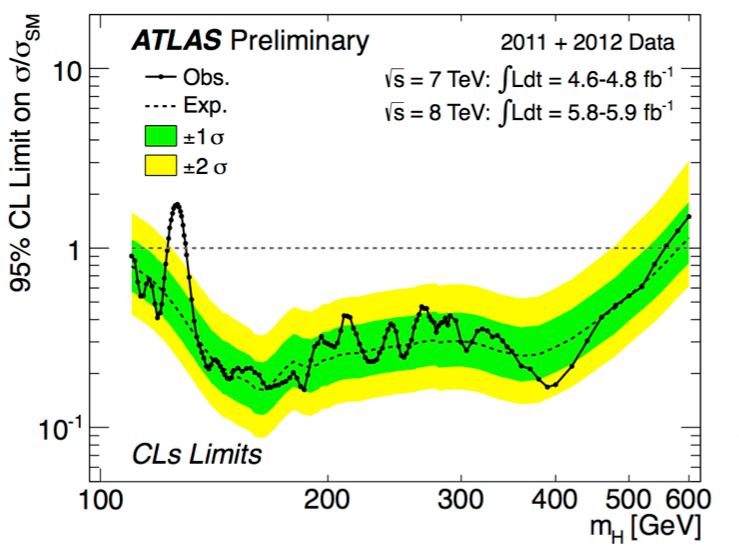The Higgs boson
(Français/English)On the 4th of July 2012, results from the 2011 and 2012 Higgs boson searches were presented at CERN and at ICHEP. The ATLAS results show a clear five standard deviation excess, consistent with a Standard Model Higgs boson with a mass of approximately 126.5 GeV. Analyses were carried out across twelve final state channels and exclude Higgs masses between 110 to 600 GeV, except within a narrow window around 126.5 GeV. In this narrow window, excesses of 4.5 and 3.4 sigma were seen in the diphoton and ZZ* to four leptons final states. These observations represent the beginning of Higgs measurements at the LHC. In particular, the properties of the observed particle need to be determined.
 Production cross-section limit, using data collected at √s = 7 and 8 TeV up to the 18th of June 2012 corresponding to approximately 11 fb-1 (full caption) |
Analysis contributions
Members of the Geneva group contributed to two important aspects of the Higgs boson search in the H → ZZ(*) → ll l'l' channel:
- The study of the background from pp → ZZ and from pp → Z + jets processes. At high four-lepton masses, the main source of background comes from pp → ZZ(*) → ll l’l’ production. At lower masses, especially in the interesting range around m4l = 125 GeV, other Standard Model processes, notably pp → Z + jets production, also contribute significantly. The contribution from non-ZZ processes cannot be reliably estimated from Monte Carlo simulation, but needs to be measured directly from data. The Geneva group played a leading role in the development of a new method based on multiple experimental control regions, dominated by different types of background processes giving rise to (Z → ll) + ee candidate events.
- The study of the electron performance, especially the measurement of the identification efficiency for low transverse-energy (ET) electrons. The decay of Higgs bosons of a mass around 125 GeV results in leptons of relatively low transverse energy. Such low energies cannot be reached by common data-driven methods based on the decays of Z → ee. Therefore, the Geneva group uses the decays of the lower mass J/Ψ particle to measure these efficiencies from ET=7 to 20 GeV. The largest systematic uncertainty on the analysis to date comes from the lack of understanding on the composition of the selected J/Ψ sample. To improve the experimental precision, the Geneva group developed a new method that can separately measure the efficiency for isolated electrons from the pp → J/Ψ → ee process and for non-isolated electrons from bb → J/Ψ → ee production, (where the b-hadron decay typically produces other particles close to the J/Ψ).
 ZZ(*) → lll'l' reconstructed mass distribution. ( full caption) |
Supporting studies
The present analyses are the result of many years of effort, during which the Geneva group has played a significant role in the construction of the ATLAS detector, trigger logic and performance studies. The group has also contributed to understanding several of the background processes, by performing several standard model analyses.
Last modified: 2012/07/04